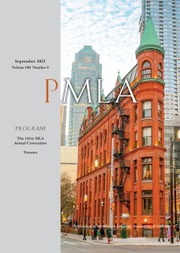No CrossRef data available.
Article contents
Fraught Intimacies: Persian and Hindu Publics in Colonial India
Published online by Cambridge University Press: 26 July 2024
Abstract
An abstract is not available for this content so a preview has been provided. Please use the Get access link above for information on how to access this content.

- Type
- Theories and Methodologies
- Information
- Copyright
- Copyright © 2024 The Author(s). Published by Cambridge University Press on behalf of Modern Language Association of America
References
Works Cited
Alam, Muzaffar. “The Pursuit of Persian: Language in Mughal Politics.” Modern Asian Studies, vol. 32, no. 2, 1998, pp. 317–49.CrossRefGoogle Scholar
Alam, Muzaffar, and Subrahmanyam, Sanjay. “The Making of a Munshi.” Comparative Studies of South Asia, Africa and the Middle East, vol. 24, no. 2, 2004, pp. 61–72.CrossRefGoogle Scholar
Bellenoit, Hayden. The Formation of the Colonial State in India: Scribes, Paper and Taxes, 1760–1860. Routledge, 2017.CrossRefGoogle Scholar
Berlant, Lauren, and Greenwald, Jordan. “Affect in the End Times: A Conversation with Lauren Berlant.” Qui Parle, vol. 20, no. 2, 2012, pp. 71–89.CrossRefGoogle Scholar
Chatterjee, Nandini. Negotiating Mughal Law: A Family of Landlords across Three Indian Empires. Cambridge UP, 2020.CrossRefGoogle Scholar
Dalmia, Vasudha. The Nationalization of Hindu Traditions: Bhāratendu Hariśchandra and Nineteenth-Century Banaras. Permanent Black, 2017.Google Scholar
Ernst, Carl. “Muslim Studies of Hinduism? A Reconstruction of Arabic and Persian Translations from Indian Languages.” Iranian Studies, vol. 36, no. 2, 2003, pp. 173–95.CrossRefGoogle Scholar
Gandhi, Supriya. “Dharmaśāstra in Aurangzeb's India: A Persian Translation of the Yājñavalkya Smṛti.” Journal of Hindu Studies, vol. 16, no. 1, 2023, pp. 33–56.CrossRefGoogle Scholar
Gandhi, Supriya. The Emperor Who Never Was: Dara Shukoh in Mughal India. Harvard UP, 2020.CrossRefGoogle Scholar
Gould, Rebecca. “Afterword to Persianate Pasts, National Presents: Persian Literary and Cultural Production in the Twentieth Century.” Iranian Studies, vol. 55, no. 3, pp. 787–89.CrossRefGoogle Scholar
Herzfeld, Michael. Cultural Intimacy: Social Poetics in the Nation-State. Routledge, 2005.Google Scholar
King, Christopher. One Language, Two Scripts: The Hindi Movement in Nineteenth Century North India. Oxford UP, 1994.Google Scholar
Kinra, Rajeev. “Revisiting the History and Historiography of Mughal Tolerance.” ReOrient: The Journal of Critical Muslim Studies, vol. 5, no. 2, 2020, pp. 137–82.CrossRefGoogle Scholar
Kinra, Rajeev. Writing Self, Writing Empire: Chandar Bhan Brahman and the Cultural World of the Early Modern Indo-Persian State Secretary. U of California P, 2015.CrossRefGoogle Scholar
Pellò, Stefano. “Persian as a Passe-Partout: The Case of Mīrā ʿAbd al-Qādir Bīdil and his Hindu Disciples.” Culture and Circulation: Literature in Motion in Early Modern India, edited by de Bruijn, Thomas and Busch, Allison, Brill, 2014, pp. 21–46.CrossRefGoogle Scholar
Rai, Mridu. Hindu Rulers, Muslim Subjects: Islam, Rights, and the History of Kashmir. Princeton UP, 2004.CrossRefGoogle Scholar
Tavakoli-Targhi, Mohamad. “Orientalism's Genesis Amnesia.” Antinomies of Modernity Essays on Race, Orient, Nation, edited by Kaiwar, Vasant and Mazumdar, Sucheta, Duke UP, 2003, pp. 92–119.Google Scholar
Wagoner, Philip. “Harihara, Bukka, and the Sultan: The Delhi Sultanate in the Political Imagination of Vijayanagara.” Beyond Turk and Hindu: Rethinking Religious Identities in Islamicate South Asia, edited by Gilmartin, David and Lawrence, Bruce B., UP of Florida, 2000, pp. 300–26.Google Scholar
Weber, Siegfried. Die persische Verwaltung Kaschmirs, 1842–1892. Österreichischen Akademie der Wissenschaften, 2007.CrossRefGoogle Scholar


